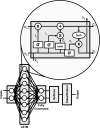Effect of time windows in LSTM networks for EEG-based BCIs
- PMID: 37007196
- PMCID: PMC10050242
- DOI: 10.1007/s11571-022-09832-z
Effect of time windows in LSTM networks for EEG-based BCIs
Abstract
People with impaired motor function could be helped by an effective brain-computer interface (BCI) based on a real-time electroencephalogram (EEG) and artificial intelligence algorithms. However, current methodologies for interpreting patient instructions from an EEG are not accurate enough to be completely safe in a real-world situation , where a poor decision would place their physical integrity at risk, such as when traveling in an electric wheelchair in a city. For various reasons, such as the low signal-to-noise ratio of portable EEGs or the effects of signal contamination (disturbances due to user movement, temporal variation of the features of EEG signals, etc.), a long short-term memory network (LSTM) (a type of recurrent neural network) that is able to learn data flow patterns from EEG signals could improve the classification of the actions taken by the user. In this paper, the effectiveness of using an LSTM with a low-cost wireless EEG device in real time is tested, and the time window that maximizes its classification accuracy is studied. The goal is to be able to implement it in the BCI of a smart wheelchair with a simple coded command protocol, such as opening or closing the eyes, which could be executed by patients with reduced mobility. Results show a higher resolution of the LSTM with an accuracy range between 77.61 and 92.14% compared to traditional classifiers (59.71%), and an optimal time window of around 7 s for the task done by users in this work. In addition, tests in real-life contexts show that a trade-off between accuracy and response times is necessary to ensure detection.
Keywords: Artificial neural network; Brain–computer interface; Deep learning; EEG; LSTM; Machine learning.
© The Author(s) 2022.
Conflict of interest statement
Consent for publicationThe authors declare no conflict of interest and have given their explicit consent to publish this manuscript.
Figures











References
-
- Alhagry S, Aly AA, El-Khoribi RA. Emotion recognition based on EEG using LSTM recurrent neural network. Int J Adv Comput Sci Appl. 2017;8:355–358. doi: 10.14569/ijacsa.2017.081046. - DOI
-
- Bishop C. Pattern recognition and machine learning. 1. Singapore: Springer; 2006.
-
- Cohen J. Statistical power analysis for the behavioral sciences. 2. Hillsdale, NJ: L. Erlbaum Associates; 1988.
LinkOut - more resources
Full Text Sources

